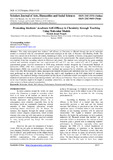Promoting Students’ Academic Self-Efficacy in Chemistry through Teaching Using Molecular Models
Abstract
This study investigated how students’ self efficacy in Chemistry is affected through the use of molecular models as contrasted with the conventional instructional strategies in the topic of Structure And Bonding (SAB). The study was carried out in Khwisero sub-county, Kakamega County, in the republic of Kenya, using quasi-experimental research design, which was implemented via the pretest-posttest with control model. The sample comprised of 309 form two students, from four secondary schools in Khwisero sub-county. The students were selected by the quota sampling method and randomly assigned into two experimental (E1 and E2) and two control (C1 and C2) groups. The experimental groups received instruction in SAB using molecular models alongside the Conventional Methods of Instruction (CMI), while their counterparts in control groups were taught using the CMI only. The Self-Efficacy Questionnaire (SEQ) was created by the researcher, validated and assessed for its reliability, and used to collect the study’s raw data. Both descriptive (mean, mean gain and standard deviation) and inferential (one-way ANOVA) analyses were performed on the data, the latter for testing the study’s null hypothesis at the 0.05 alpha level of statistical significance. The empirical findings clearly pointed out that the use of molecular models was superior to the conventional methods of instruction in terms of promoting students’ self-efficacy in Chemistry. These results have several implications in the way Chemistry ought to be taught at secondary school level, in order for the subject to compete favorably with other sciences in future national examinations
URI
https://www.semanticscholar.org/paper/Promoting-Students%E2%80%99-Academic-Self-Efficacy-in-Using-Wangila/72dbb3d54baf0554d88f5926fabf437423aa8bc3http://hdl.handle.net/123456789/5788

